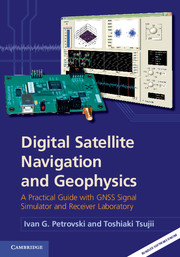 Digital Satellite Navigation and Geophysics
Digital Satellite Navigation and Geophysics Book contents
- Frontmatter
- Contents
- Foreword
- Preface
- 1 Methods of positioning with navigation satellites
- 2 Presentations and applications of GNSS orbits
- 3 GNSS signal generation in transmitters and simulators
- 4 Signal propagation throughthe atmosphere
- 5 Receiver RF front end
- 6 Real-time baseband processor on a PC
- 7 Multipath
- 8 Optimization of GNSS observables
- 9 Using observables in navigation-related tasks
- 10 Electromagnetic scintillation of GNSS signal
- 11 Geophysical measurements using GNSS signals
- 12 Aiding baseband and navigation processors using INS
- Next step – RF lab
- Index
- References
2 - Presentations and applications of GNSS orbits
Published online by Cambridge University Press: 05 March 2012
- Frontmatter
- Contents
- Foreword
- Preface
- 1 Methods of positioning with navigation satellites
- 2 Presentations and applications of GNSS orbits
- 3 GNSS signal generation in transmitters and simulators
- 4 Signal propagation throughthe atmosphere
- 5 Receiver RF front end
- 6 Real-time baseband processor on a PC
- 7 Multipath
- 8 Optimization of GNSS observables
- 9 Using observables in navigation-related tasks
- 10 Electromagnetic scintillation of GNSS signal
- 11 Geophysical measurements using GNSS signals
- 12 Aiding baseband and navigation processors using INS
- Next step – RF lab
- Index
- References
Summary
“Therefore it is quite natural, that the Earth, being very heavy in comparison to bodies dropping free on it, stays everywhere motionless under the force from much smaller weights and as if just receives everything, which falls down on her.”
Claudius Ptolemy, Almagest, Book 1–7.In order to use GNSS for almost any practical application or to simulate a GNSS signal, we need to be able to define satellite coordinates at any moment of time. In this chapter we look at GNSS satellite orbits. We consider their mathematical presentations and requirements of constellation design. The subject matter of this chapter in relation to other chapters is shown on Figure 2.1
Development of models for celestial body movements from Ptolemy to Einstein
Movement of satellites around the Earth is described using mathematical instruments and models which were developed for describing the movement of the planets. The first known applicable mathematical model for orbital movement of the celestial bodies was developed by Claudius Ptolemy, who was working in the first century AD in Alexandria. He created the first accurate working model of a celestial body’s motion [1].
Information
- Type
- Chapter
- Information
- Digital Satellite Navigation and GeophysicsA Practical Guide with GNSS Signal Simulator and Receiver Laboratory, pp. 37 - 66Publisher: Cambridge University PressPrint publication year: 2012